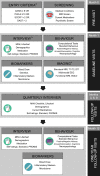Tulsa 1000: a naturalistic study protocol for multilevel assessment and outcome prediction in a large psychiatric sample
- PMID: 29371263
- PMCID: PMC5786129
- DOI: 10.1136/bmjopen-2017-016620
Tulsa 1000: a naturalistic study protocol for multilevel assessment and outcome prediction in a large psychiatric sample
Abstract
Introduction: Although neuroscience has made tremendous progress towards understanding the basic neural circuitry underlying important processes such as attention, memory and emotion, little progress has been made in applying these insights to psychiatric populations to make clinically meaningful treatment predictions. The overall aim of the Tulsa 1000 (T-1000) study is to use the NIMH Research Domain Criteria framework in order to establish a robust and reliable dimensional set of variables that quantifies the positive and negative valence, cognition and arousal domains, including interoception, to generate clinically useful treatment predictions.
Methods and analysis: The T-1000 is a naturalistic study that will recruit, assess and longitudinally follow 1000 participants, including healthy controls and treatment-seeking individuals with mood, anxiety, substance use and eating disorders. Each participant will undergo interview, behavioural, biomarker and neuroimaging assessments over the course of 1 year. The study goal is to determine how disorders of affect, substance use and eating behaviour organise across different levels of analysis (molecules, genes, cells, neural circuits, physiology, behaviour and self-report) to predict symptom severity, treatment outcome and long-term prognosis. The data will be used to generate computational models based on Bayesian statistics. The final end point of this multilevel latent variable analysis will be standardised assessments that can be developed into clinical tools to help clinicians predict outcomes and select the best intervention for each individual, thereby reducing the burden of mental disorders, and taking psychiatry a step closer towards personalised medicine.
Ethics and dissemination: Ethical approval was obtained from Western Institutional Review Board screening protocol #20101611. The dissemination plan includes informing health professionals of results for clinical practice, submitting results to journals for peer-reviewed publication, presenting results at national and international conferences and making the dataset available to researchers and mental health professionals.
Trial registration number: NCT02450240; Pre-results.
Keywords: adult psychiatry; anxiety disorders; eating disorders; magnetic resonance imaging; mental health.
© Article author(s) (or their employer(s) unless otherwise stated in the text of the article) 2018. All rights reserved. No commercial use is permitted unless otherwise expressly granted.
Conflict of interest statement
Competing interests: None declared.
Figures

References
-
- Kessler RC, Ruscio AM, Shear K, et al. . Epidemiology of anxiety disorders. Curr Top Behav Neurosci 2010;2:21–35. - PubMed
Publication types
MeSH terms
Substances
Associated data
Grants and funding
LinkOut - more resources
Full Text Sources
Medical
